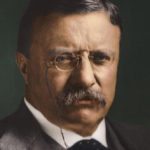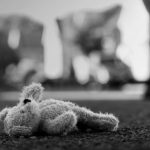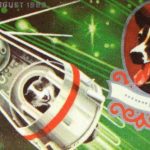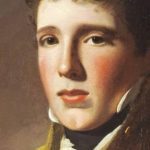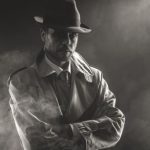 Weird Stuff
Weird Stuff  Weird Stuff
Weird Stuff  Animals
Animals 10 Inspiring Tales of Horses Being Human
 Mysteries
Mysteries Top 10 Haunting Facts About the Ghost Ship MV Alta
 History
History 10 Surprising Stories About the Texas Rangers
 Humans
Humans 10 Philosophers Who Were Driven Mad by Their Own Theories
 Miscellaneous
Miscellaneous 10 Video-Game-Worthy Weapons and Armors from History
 Weird Stuff
Weird Stuff 10 Psychics Who Accurately Predicted Wartime Events
 The Arts
The Arts 10 Pieces of Art Inspired by a Broken Heart
 Health
Health 10 Science Fiction-Sounding New Medical Treatments
 History
History 10 Surprising Facts About the Father of Submarine Warfare
 Weird Stuff
Weird Stuff 10 Times Real Laws Were Based on Bizarre Hypotheticals
 Animals
Animals 10 Inspiring Tales of Horses Being Human
 Mysteries
Mysteries Top 10 Haunting Facts About the Ghost Ship MV Alta
Who's Behind Listverse?

Jamie Frater
Head Editor
Jamie founded Listverse due to an insatiable desire to share fascinating, obscure, and bizarre facts. He has been a guest speaker on numerous national radio and television stations and is a five time published author.
More About Us History
History 10 Surprising Stories About the Texas Rangers
 Humans
Humans 10 Philosophers Who Were Driven Mad by Their Own Theories
 Miscellaneous
Miscellaneous 10 Video-Game-Worthy Weapons and Armors from History
 Weird Stuff
Weird Stuff 10 Psychics Who Accurately Predicted Wartime Events
 The Arts
The Arts 10 Pieces of Art Inspired by a Broken Heart
 Health
Health 10 Science Fiction-Sounding New Medical Treatments
 History
History 10 Surprising Facts About the Father of Submarine Warfare
Top 10 Most Heartbreaking Facts about Jonestown
Everyone knows the basics of Jonestown. How cult leader Jim Jones attempted to create a utopia in South America, and how it ended with the death of over 900 followers by cyanide-laced Flavor-Aid (no, it wasn’t Kool-Aid!)
Jones was the charismatic yet deeply troubled leader of the Peoples Temple, a religious movement that culminated tragically in the infamous events of Jonestown. Born in 1931, Jones founded the Peoples Temple in Indianapolis in the 1950s, espousing ideals of racial equality and social justice. However, as the movement grew, it became increasingly authoritarian and cult-like, eventually relocating to Guyana, where Jonestown was established. The harrowing events of Jonestown remain one of the most shocking incidents in modern history, serving as a cautionary tale about the dangers of unchecked power and the vulnerability of those seeking meaning and belonging.
But there’s much more to this story, things that make this already devastating event even more horrific.
Related: 10 School Massacres That Almost Happened
10 No Family Contact for Months
Jonestown was located in a completely remote area in the Guyanan jungle. The closest major city was Georgetown, but it was impossible to get there without a vehicle or a brave guide. Thus, citizens essentially had no way to leave the compound without the explicit permission of Jones, which he rarely gave.
Furthermore, Jones limited contact with the outside world as much as possible. This extended to family and friends back home. The Concerned Relatives was created by ex-members of the Temple and consisted mainly of family members of people who had been taken to Jonestown. With no communication and no idea what was happening over there, this group took it into their own hands to try and bring their family members back home.[1]
9 Jonestown Inspiration: Another Cult Mass Suicide 20 Years Later
Although not as famous as Jonestown, the group known as Heaven’s Gate has become synonymous with their infamous final act.
In 1997, 39 members of the religious group ate poisoned applesauce in an attempt to make it to the “next level,” which they thought could be achieved through death. The group believed that after their deaths, a UFO would raise their souls to another level of existence.
Heaven’s Gate, while still tragic, differs from Jonestown in some major ways, including the smaller scale of deaths. No one under 18 was allowed to join the group, meaning all 39 deaths were adults. There’s also no evidence that members were coerced or isolated in any way. Despite these contrasts, this mass suicide just over 20 years after the largest in modern history certainly brought cults and the subject of hive minds back into popular culture.[2]
8 Jones Trained the Members to Trust Him
Part of the reason the residents of Jonestown were so quick to drink the poison was because Jones had prepared them to believe that they would live.
Jones’s “White Nights” consisted of him insisting it was time for the group to commit mass suicide. Almost everything that proceeded after that closely follows the events of the final White Night. Members were forced to drink or eat things that Jones claimed would kill them while he preached about the end of times. They, of course, were not poisoned. Jones would then announce it had been a loyalty test that everyone who drank/ate had passed.
Therefore, many members of the Temple believed the cyanide-laced Flavor-Aid to be another placebo that would not harm them.[3]
7 One Member Tried to Have Jones Let Them Go
After Jones began to rant and rave about how the only way to save themselves was through “revolutionary suicide,” some Peoples Temple members were brave enough to try and convince him that there were other ways out of the situation.
Christine Miller is the most famous example of this. She argued that an airlift to the Soviet Union could save the group, but Jones claimed that was unrealistic. Miller went on to say that if the group destroyed themselves, the U.S. government would have beaten them. In contrast, if they stayed alive, there would always be hope. Jones responded that everybody dies eventually, and then “hope runs out.”
Miller’s bravery in the face of chaos and a corrupt leader reminds us how important it is to advocate for ourselves and stand up for others, even when it seems futile.[4]
6 Only 87 People Survived
Almost none of the members of Peoples Temple in Jonestown survived the massacre. Still, a few were lucky enough to make it out of Guyana. Most of these survivors happened to be out of the confines of the camp that day or lived in Georgetown (the capital of Guyana).
Arguably, the most famous survivor to actually witness the massacre, Hyacinth Thrash, hid under her bed when she heard the sound of gunshots coming from the center of town. Ignoring Jones’s call for a town meeting, Thrash fell asleep waiting and woke up a few hours later to a scene from a horror film—her friends and family strewn across the grounds.
Interestingly, three of Jones’s sons survived due to being in Georgetown on that fateful day.[5]
5 Most of the Residents Were Outcasts
Jonestown was created as a utopian society made up of members of the Peoples Temple. Started by Reverend Jim Jones, the Peoples Temple was started in 1954 to promote the ideals of Christianity and socialism with a huge emphasis on racial equality.
During the tumultuous times of the Civil Rights Movement, many poorer Americans and people of color felt rejected by the government and mainstream churches. Jones’s Peoples Temple offered marginalized groups a place to discuss religious and political issues in a safe environment with a leader who didn’t look down on them.
Because many members of the church were minorities or social outcasts in America, they made up the majority of the residents of Jonestown. The fact that so many Jonestown victims were simply searching for a place to feel welcome and equal to others makes the tragedy that much more devastating.[6]
4 They Were Close to Being Saved
Although many of the inhabitants of Jonestown had gone to the remote Guyana town willingly, no one was allowed to leave without Jim Jones’s explicit permission (armed guards were kept on the outskirts of the camo to prevent escapees). Because of his deep paranoia of the government and outsiders, hardly anyone was allowed to depart the encampment for any reason.
Of course, most residents had family and friends back home in the United States who were wary of the lack of communication they’d been hearing from Peoples Temple members. After multiple complaints and rumors of abuse and human rights violations from Jonestown, the Concerned Relatives group was created.
Pressure from this group is what eventually convinced Congressman Leo Ryan to visit Guyana himself. Unfortunately, Ryan’s visit, which was intended to help Jonestown residents get back home, is what led to Jones’s orders to shoot the congressman and others and begin the murder-suicide.[7]
3 Almost a Third of the Victims Were Children
Jim Jones’s ideas about parenthood were pretty outside of the box, and this is reflected in his ideologies and leadership. Rather than being raised by their parents, children were brought up in communal care and were sometimes only allowed to see their biological parents for a few minutes each day. Jones himself was seen as the ultimate father, as he was called “Dad” by most members of the Temple, adults included.
Out of 918 dead, at least 303 victims were under the age of 18. Jones prided himself on his “Rainbow family,” referencing the non-white children he and his wife adopted. Jim Jr. (the “black son”) and Stephan (Jones’s only biological child), two of Jones’s sons, happened to be out of town at a basketball game that day and thus survived the massacre.[8]
2 It Wasn’t Really a Suicide
Jonestown is often billed as history’s largest murder-suicide, but this isn’t exactly true. The colloquial name for it is more accurate: The Jonestown Massacre. Although the event is technically a “suicide” in that victims did (generally) poison themselves, it was far from their own choice.
Terrified that U.S. Congressman Leo Ryan would return to America with a report saying that Jonestown was unsafe and ruin his utopian plans, Jim Jones ordered a shooting that resulted in Ryan’s death.
At this point, it was clear that the jig was up. Once the U.S. government learned that one of its congressmen had been murdered, Jonestown would be done for. In a flurry of fear and paranoia, Jones declared that it would be better for everyone if they simply killed themselves rather than go back to the U.S. He claimed “death is a million times preferable to 10 more days of this life. If you knew what was ahead of you… you’d be glad to be stepping over tonight.”
Members who refused to drink the cyanide-laced Flavor-Aid were either shot or injected with the poison. Some attempted to escape by running into the jungle, but Jones warned them that there was little chance of survival there and convinced most that it was easier to die here than in the wild.
With little choice in the matter, many historians argue that calling Jonestown a murder-suicide is incorrect and takes away from the tragedy that occurred that day. Dr. John Hall says, “But the adults at Jonestown lived within their own bubble of reality, and in the end, they had come to believe that their world was under siege from the outside.” With all the coercion, lies, and brainwashing going on, the lines are certainly blurred.[9]
1 The Kids Went First
Despite the controversy surrounding the adults at Jonestown, there’s no doubt that the children of the compound were murdered. Besides the fact that they were too young to understand the weight of their own decisions, nearly all the children at Jonestown had to be forced to drink the poisoned drink by their parents and other loved ones. There are even reports of syringes being used to squirt the poison in the mouths of babies as young as three months old.
Famously, when recounting that fateful day, Jonestown survivor Odell Rhodes began by saying, “They started with the babies,” an ominous beginning to a terrifying ordeal.
Allegedly, Jones ordered the children to go first as a way to take away the adults’ hopes of escape or survival. He figured that once parents were forced to kill their own children, they would take the poison themselves more easily.[1]
